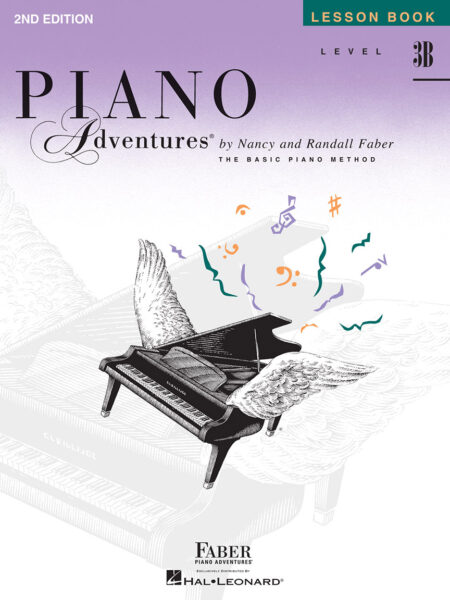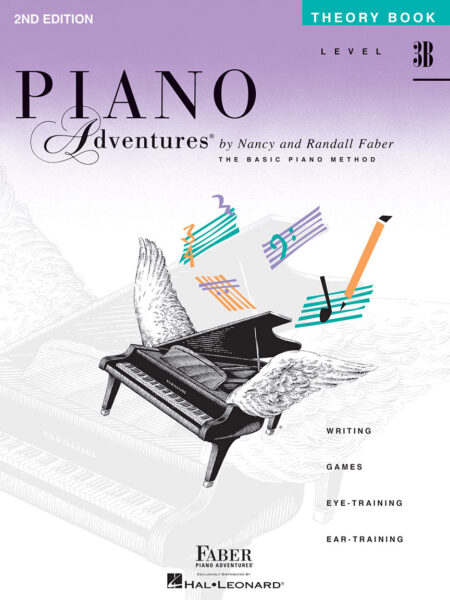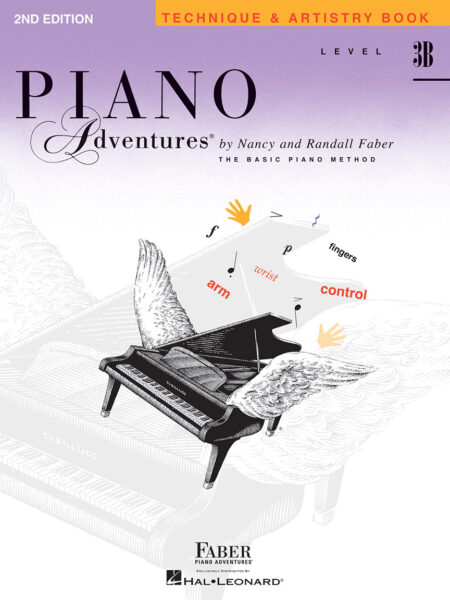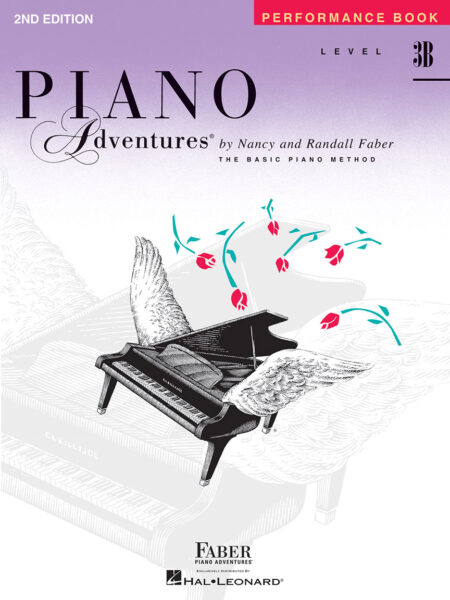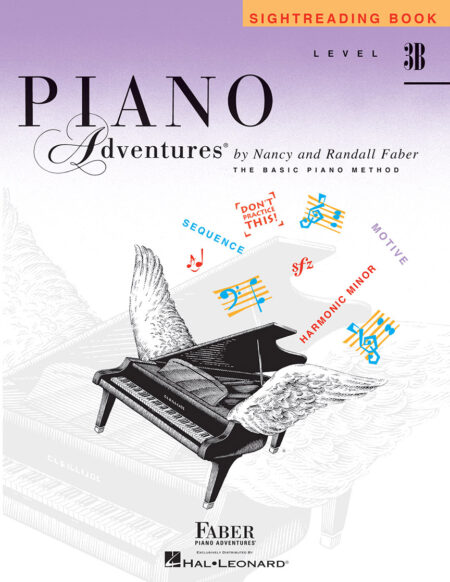
20Questions and Answers for Level 3B
About the Level 3B Books
- The Level 3B Lesson Book starts with a Level 3A Review, “Get Ready for Take-off!” Is this important to do?
- Should I use all four core Level 3A Books: Lesson, Theory, Technique & Artistry, and Performance?
- How do I fit all four core books into a lesson?
- The “Key of A Minor” pages present both 1 and 2-octave minor scales. Should both be taught at the same lesson?
- How is transposition developed in Level 3B?
- How is octave playing introduced?
- Why is it important to present the 12-bar blues (pp. 44-45)?
- How is the LH developed at Level 3B?
- What are the 3B Technique Secrets and how do they help?
- When should I begin using the 3B Sightreading Book and how?
- Are there plans for a 3A-3B Gold Star Performance Book?
About the Level 3B Student
- Are there any student-student duets at Level 3B?
- As 16th notes are presented, what is the best way for students to count? (pp. 54-55)
- Where can I find more lead sheets for the 3B student?
- When can a student begin a Literature Book in Level 3B? Which level of the series should I use?
- What pieces could a Level 3B student play for extra fun?
- Do 3B students compose and improvise?
- Can I teach Level 3A students in an online lesson? What are some teaching tips?
About the Level 3B Adventure Learning Videos
About the Level 3B Audio Files
1. The Level 3B Lesson Book starts with a Level 3A Review, “Get Ready for Take-off!” Is this important to do?
The Level 3A Review that begins Level 3B is a handy teacher assessment tool. Use it for students graduating to Level 3B as well as transfer students. The Level 3A Review helps the teacher assess what is understood and what needs more support.
Rhythm review includes metric counting in 6/8 and 4/4 rhythms with triplets. Reading review covers upper and lower ledger lines and intervals through the 7th. Theory concepts include completing G, F, D, and chromatic scales, labeling I, IV, and V7 chords in various keys, dynamic and tempo marks, and other musical terms.
Areas in which the student lacks confidence allow the teacher to “review and renew” understanding. Explore board work, flashcards, and cheerful questions and answers to review concepts together. Consider using the 3A Sightreading Book for students who need a reading boost. This will help develop faster recognition of melodic and rhythm patterns as students begin Level 3B.
Level 3B Lesson Book
Get Ready for Take-off! (Level 3A Review, pp. 4-5)
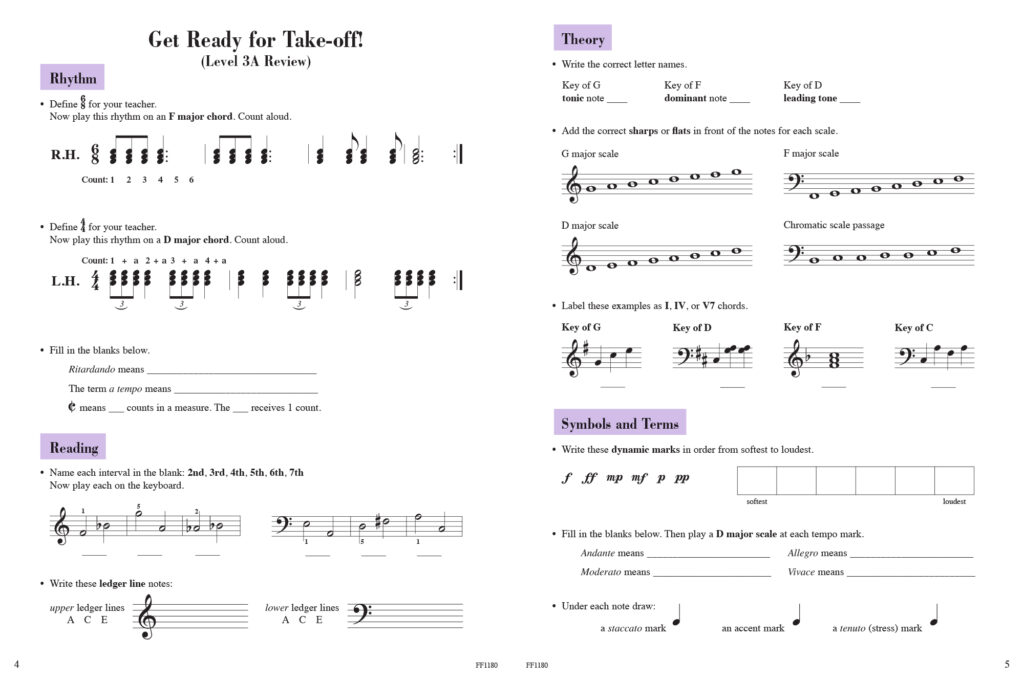
2. Should I use all four core Level 3B Books: Lesson, Theory, Technique & Artistry, and Performance?
The four core Level 3B Books form a set for wholistic learning and correlate by page number. The Theory, Technique & Artistry, and Performance Books give fresh perspectives for concepts in the 3B Lesson Book. It is possible a teacher could substitute a different solo book than the Performance Book. However, the precise tie-in of concepts in the core books is hard to beat. The intermediate student is making connections—connections that form the “musical mind”—and the more efficient these connections are made the better.
The core books address things easy to miss in lessons: ear-training, sightreading, improvisation, and importantly, technique for skill and artistry. Taking the time for deeper learning using the four core Level 3B Books prepares students for success in Level 4.
3. How do I fit all four core books into a lesson?
The three most important books are the Lesson Book, the Theory Book, and the Technique & Artistry Book. A 30-minute lesson allows about 10 minutes per book. A 45-minute lesson, recommended for the 3B student, offers a distinct time advantage for using all four books.
If time is short, consider demonstrating the Performance Book piece while the student watches the music. Give a few pointers, then assign to learn at home as your own “adventure piece.” This gives the teacher an opportunity to see what is easy and what is challenging at the next lesson.
For the Theory Book, the teacher might do the first example on a page with the student, then assign to complete at home. With careful lesson planning and efficient use of lesson time, the four books can be implemented, even if one book is not covered in some lessons.
4. The “Key of A Minor” pages present both 1 and 2-octave minor scales. Should both be taught at the same lesson?
For many students, the 1-octave natural and harmonic minor scales, with primary chords, is a good, manageable assignment. Other students may be ready to launch into the 2-octave harmonic minor scale. Consider deleting the G sharp (raised 7th) first to form a natural minor scale. Then follow with the harmonic minor scale shown. Playing slowly with careful attention to fingering will be the “secret scale sauce.”
Level 3B Lesson Book
Key of A Minor (pp. 6-7)

5. How is transposition developed in Level 3B?
The student has been playing outside a “5-finger position” for two levels prior to this—Level 2B and Level 3A. At 3B, transposing involves close attention to starting positions. Does the RH start on the 3rd note of the scale or the 5th, for example? Transposition brings new musical challenges with finger substitution, shifting chords, and octaves. Using the “ear,” thinking intervals, and relating tonic, dominant, and leading tone all bring these important theory skills to a higher level.
An entire song, or just a portion of a piece can be transposed. Students become “keyboard smart” with short transposition workouts.
Level 3B Lesson Book
"Sea Chantey" (transpose the Theme and Variation 1 to Dm, pp. 16-17)

"Rage Over a Lost Penny" (transpose mm. 1-8 to C and F, pp. 18-19)

"Cat Patrol" (transpose mm. 1-16 to Am, pp. 24-25)

6. How is octave playing introduced?
The octave is presented using an “Interval Review” exercise that expands from the interval of a 2nd through the octave. Each hand plays the exercise. Students transpose to G and D major, using the appropriate sharps.
Most students at Level 3B can reach an octave. If so, the next step is to play “The Scale in Octaves” with a rest between each octave to relax the hand and reset over the next keys. This octave exercise can be transposed to many scales in future lessons: G, F, Am, Em, Dm, even the chromatic scale!
The Creative activity at the end challenges students to play “Twinkle, Twinkle Little Star” in octaves in the key of G. Repeat with the LH.
Level 3B Lesson Book
The Scale in Octaves (blocked octave, p. 30)

Humoresque (5th-octave ostinato, pp. 34-35)

The Bear (broken octave, pp. 36-37)

Level 3B Technique & Artistry Book
The Faraway Castle (pedaled, L.H. broken octave, p. 21)

Adagio in Blue (pedaled, R.H. broken octave, p. 29)

7. Why is it important to present the 12-bar blues (pp. 44-45)?
The 12-bar blues accomplishes two excellent things for the 3B student:
- It offers a new, exciting blues sound giving variety to the repertoire.
- It highlights I, IV, and V triads using an organized chord progression—12 bars!
In “Barrelhouse Blues,” the student sees the 12-bar pattern with a new, bluesy LH pattern. “The Piano Playin’ Chocolate Eater’s Blues” follows with yet another blues-y LH pattern for the 12-bar progression.
Level 3B Lesson Book
Exploring the 12-Bar Blues, Barrelhouse Blues (pp. 44-45)

In the Theory Book, students write whole note chords for the 12-bar blues in C major. Next, they write the Roman numerals and then chord letter names.
Level 3B Theory Book
The 12-Bar Blues (p. 21)

8. How is the LH developed at Level 3B?
Left hand development expands at Level 3B with 2-octave scales in Am, Em, and Dm, chord inversions (blocked and broken), and octaves (blocked and broken). More challenging LH melodies and greater agility for quick LH 16th-notes also occurs.
Level 3B Lesson Book: 2-octave minor scales, chord inversions, octaves
Two-Octave A minor Scale (p. 7)

C Major Chord Inversions (p. 48)

The Scale in Octaves (p. 30)

Level 3B Technique & Artistry Book: broken octaves, LH solo, 16th-note passages
The Faraway Castle (p. 21)

Campfire Guitar (p. 33)
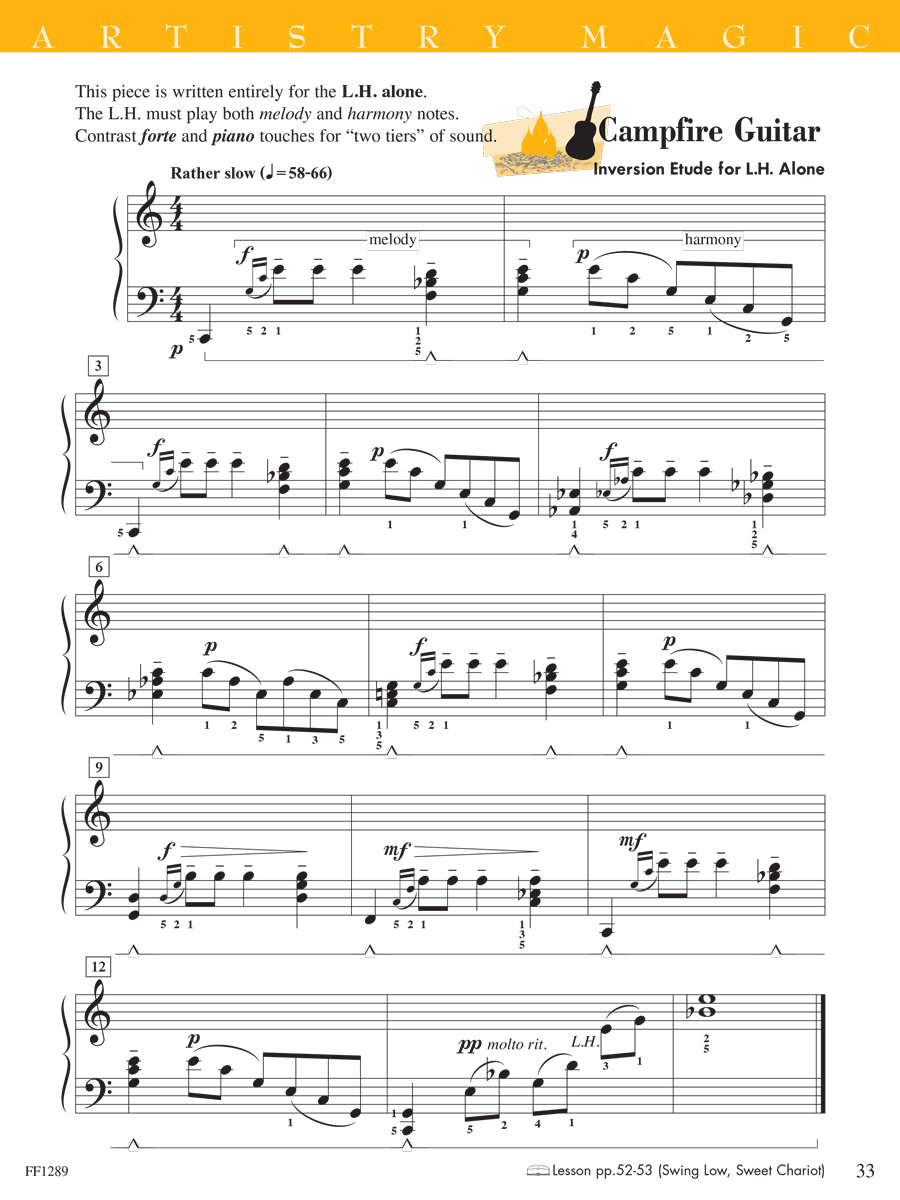
Czerny’s Allegro (p. 37)

9. What are the 3B Technique Secrets and how do they help?
Technique at the piano requires more than finger muscles. It involves sophisticated body motion between the body, arm, wrist, and finger. We call these motions “technique gestures.”
At each level of Piano Adventures, the student is introduced to level-appropriate Technique Secrets that promote fluent playing while preventing bad habits. These “secrets” are used as daily warm-ups for the exercises that follow in the book. This combination of secrets and exercises leads to an Artistry Magic Piece at the end of each unit. These pieces allow the young student to demonstrate artistry based on fine technique learned earlier.
Level 3B Technique & Artistry has 4 Technique Secrets, each with a unique name.
- Closed Hand for Scale Passages (Finger Fireworks)
- The Up-Touch (Finger Springs)
- Voicing the Melody (Melody Maker)
- Open Hand for Extensions (Hand Toss)
Check out sample videos of Technique Secrets here.
Level 3B Technique & Artistry
Level 3B Technique Secrets (pp. 2-3)

10. When should I begin using the 3B Sightreading Book and how?
The Level 3B Sightreading Book builds confident intermediate readers in two ways: recognition of individual notes and perception of rhythmic and melodic patterns.
The book is organized into sets of 5 exercises, for 5 days of practice. Each set presents variations on a piece from the Level 3B Lesson Book. Play one exercise a day, completing one set per week.
Students may begin the Level 3B Sightreading Book with the first piece in the 3B Lesson Book, “Energico.” Integrating sightreading as the student’s skill expands builds on this important principle: Notes and chords that do not change their location on the staff are integrated into compositional patterns that do change. Permanence and change come together for musical literacy!
Here are several ways to use the Level 3B Sightreading Book.
- Teachers listen to the sightreading example for just “Day 1” at the lesson. Assign the next pages of the 5-day set to sightread at home. At the following lesson, the teacher might choose one sample “Day” from that set to hear. Then assign the next set.
- If teaching 30-minute lessons, teachers might consider using the Sightreading Book in place of the Performance Book.
- Some teachers enjoy using the Sightreading Book at the lesson to introduce a new note or piece. The student then learns the correlating Lesson Book piece at home as an independent study.
- The Sightreading Book can be used as a final end-of-level project. Before starting Level 4, take several weeks to assign multiple pages of the 3B Sightreading Book, supported with a FunTime Book. Students can enjoy a change of pace in their practice routine, while celebrating all the keys, chords, and rhythms they have learned.
Level 3B Sightreading Book
Table of Contents (pp. 2-3)

Sightreading Skill (pp. 4-5)

Energico (pp. 6-9)


11. Are there plans for a 3A-3B Gold Star Performance Book?
At this time there are no plans for a Gold Star Performance Book beyond Level 2B. Instead, students are encouraged to enjoy the many appealing pieces in the FunTime Piano Books and explore the great repertoire in Piano Literature Book 1 and Piano Literature Book 2.
About the Level 3B Student
12. Are there any student-student duets at Level 3B?
A student-student duet can be found in the 3B Performance Book. (See below.)
Level 3B Performance Book
On Wings of Song (student-student duet, pp. 26-27)


There are also duets in the Developing Artist Literature Books: Preparatory, 1, 2, and 3 that could be accessible for 3B students.
Preparatory Piano Literature
Melody (Beyer, pp. 14-15)

Piano Literature Book 1
Waltz for Four Hands (Wohlfahrt, pp. 24-25)

Piano Literature Book 2
Polka (Hummel, pp. 24-25)

Piano Literature Book 3
Rondo for Four Hands (Diabelli, pp. 40-45)



Lastly, many 3B students may be able to play a Teacher Duet from the PreTime, PlayTime, or ShowTime Books with a sibling or younger student in that level.

13. As 16th notes are presented, what is the best way for students to count? (pp. 54-55)
Counting “1 e + a 2 e + a,” and so forth, is a necessary musicianship skill for all intermediate players. It takes time, however, to have this kind of counting feel natural and be easily verbalized.
Just as important is to recognize the 3 main 16th-note rhythm patterns. (See below.) Once these are internalized in the ear and recognized visually, 16th-note patterns become part of the student’s rhythm “tool box.”
It’s a good idea to have students write the 3 rhythm patterns on the board or practice sheet. This keeps it in the forefront of what is known and understood.
In reality, most professional musicians are not counting “1 e + a, 2 e + a” throughout the music. More often they are recognizing patterns that flow effortlessly from their rhythm tool box. That is the concept with the three exercises, “Keyboard Rhythm,” “Drummer at the Keyboard,” and “Rhythm Puzzle.” (See below.)
“I’ve got rhythm and I’ve got rhythm patterns!”
Level 3B Lesson Book
Sixteenth (16th) Notes (pp. 54-55)

14. Where can I find more lead sheets for the 3B student?
Lead sheets are one of the best ways ever to actively apply the theory of major and minor chords, learn to create with different accompaniment patterns, and be able to play scores of songs.
Level 3B Lesson Book
Finale by Dvořák (lead sheet, pp. 20-21)
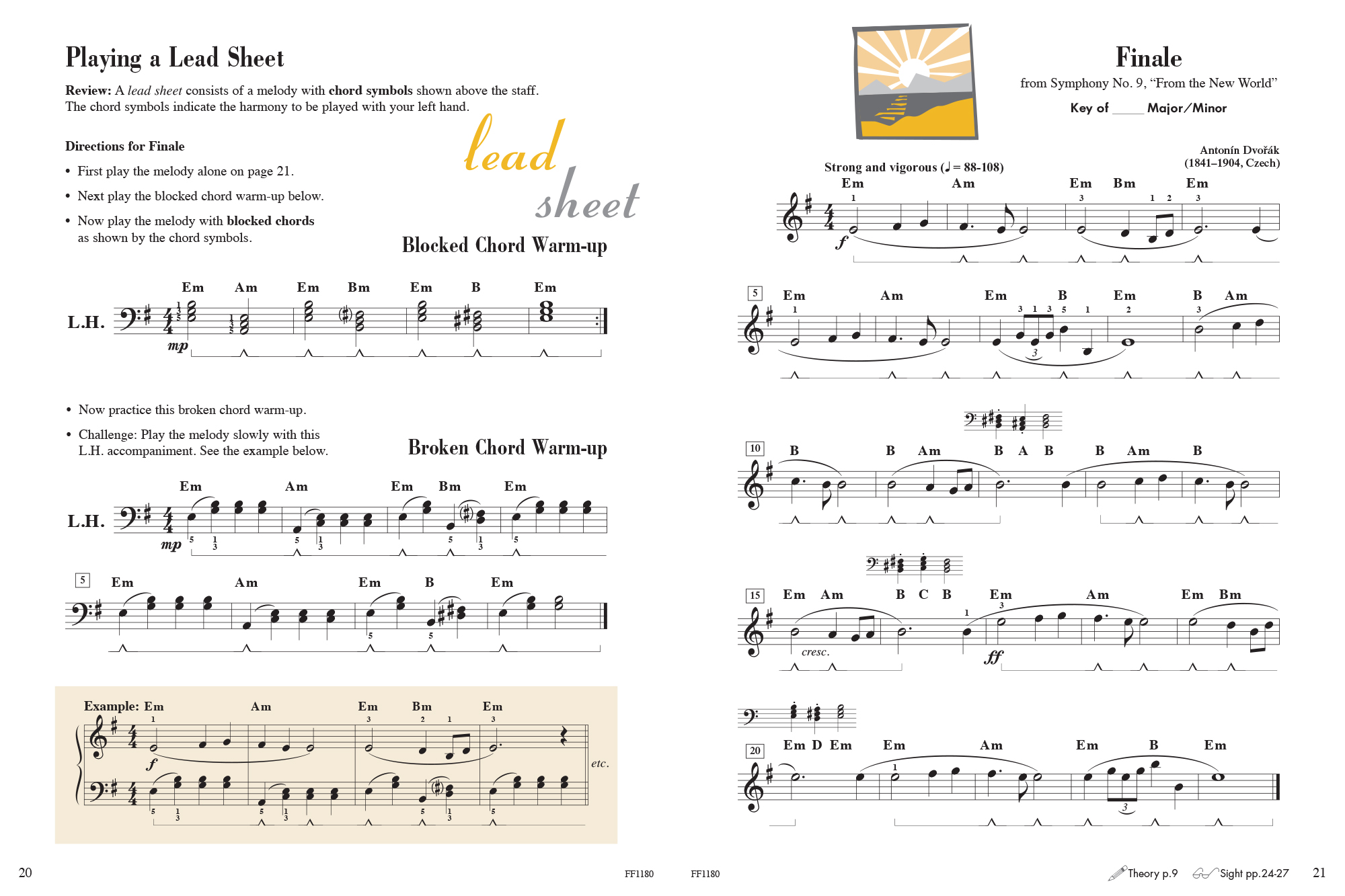
More Level 3B lead sheets for download are coming soon.
15. When can a student begin a Literature Book in Level 3B? Which level of the series should I use?
At Level 3B, a student could start Piano Literature Book 2, depending on the student’s interest and ability.
16. What pieces could a Level 3B student play for extra fun?
For extra Level 3B fun, FunTime Piano Books offer a variety of styles with many familiar songs.

Students have a chance to:
- be adventurous applying the many things learned so far.
- have more “freedom” at the keyboard as a result.
- be a bit more “fearless” with reading and technique basics already established.
And that’s fun!
3B students could begin a FunTime Book at any time in the 3B Lesson Book. The student’s interest can play a big part in the style and the piece chosen.
Here are a few favorites:
FunTime Disney Book
Cruella de Vil (pp. 6-7)

Watch a video!
FunTime Hits Book
Can’t Stop the Feeling (pp. 30-31)

Watch a video!
FunTime Christmas Book
Let It Snow! Let It Snow! Let It Snow! (pp. 28-29)

Level 3B students may also enjoy the Piano Adventures Level 3B Christmas Book and various 3B sheets.
17. Do 3B students compose and improvise?
There are many opportunities to compose and improvise in Level 3B. These activities are integrated throughout the level and bring support to new concepts.
In the 3B Lesson Book, students play a familiar melody in octaves “by ear.” They make up their own endings to a piece using triads. With a 3B lead sheet, students create the harmony using major and minor triads.
Level 3B Lesson Book
The Scale in Octaves (Creative Question, p. 30)

Tropical Island (Creative Question, pp. 40-41)

Finale by Dvořák (lead sheet, pp. 20-21)

Students compose an Em melody over an Alberti bass, write their own 16th-note rhythms, and create a LH octave “Bear Dance” piece.
Level 3B Theory Book
Serenade in E minor (p. 7)

The Bear’s Dream (p. 16)

Write 16th Note Rhythms (p. 29)


18. Can I teach Level 3B students in an online lesson? What are some teaching tips?
Yes, it is completely possible to teach Level 3B core books in an online lesson, such as Zoom.
The best way to do this is through subscribing to the Teacher Atlas and using its screen-sharing capability. All books in the Faber Library are available for viewing and screen sharing—including the Level 3B method books and the supplementary FunTime Piano Books.
Here are some ideas for teaching the Level 3B Lesson Book in an online lesson.
NOTE: Have the student become very familiar with the music before playing. Accomplish this through questions that require active responses from the student. Keep the discussion light, upbeat, and “congratulatory” as the student answers.
Let’s apply this to Unit 1, “Key of A Minor.” These are sample ideas. Teachers can create original questions and responses.
Level 3B Lesson Book
Key of A Minor (p. 6)

Sample Online Questions for “Key of A Minor”
- What is the title at the top of the page?
“Yes, Key of A Minor.”
- When we say, “Key of A Minor” we mean a lot more than just the A key on the piano. We mean a kind of “backpack of information” that includes an A minor scale, primary chords in A minor, tonic and dominant and leading tone in A minor, and so forth. Let’s explore further.
- Would you slowly read the text at the top of the page?
“Very good.”
- What’s the 6th tone of the C scale?
“Correct, A.”
- I’m going to put my RH thumb on A and play the A natural minor scale. (Do) Sounds nice, doesn’t it?
“Your turn.”
- Now, counting up 6 keys is a little long. Musicians want answers fast! Look at that little keyboard on the top right. We’re going to take that short cut and down DOWN 3 half steps.
I’ll go first. My 2nd finger finds C and then I count down by half steps.
(Play and say) “C, 1 2 3. I land on A.”
“Your turn. Good! Find another C and try it.”
- Let’s look at No. 2 on the page, “The A Natural Minor Scale.” Are there any sharps or flats?
“You’re right. No sharps or flats.”
- Will you play the A natural minor scale hands separately? Listen for a steady beat . . .
(Continue in this manner through the page.)
About the Level 3B Adventure Learning Videos
19. What are the Adventure Learning Videos?
These videos feature close-ups of the hands with simple text that taps the student’s “musical mind” with theory analysis and technique tips.
The Adventure Learning Videos for Level 3B are currently in progress and should be completed at the end of 2022. They can be very useful in a variety of ways and are modeled after the Primer Adventure Learning Videos.

About the Level 3B Audio Files
20. What are the audio files and how should I use them?
Orchestrated accompaniments for Level 3B pieces are available in the Audio Cloud and Piano Adventures Player app. Have fun exploring with your students!
Preview a track a week before teaching it at the lesson. As you listen together, discuss the sound. Is the piece happy or sad? Is the tempo fast or slow? Can you name one of the instruments that is playing?
Playing with a background accompaniment demands correct rhythm, and can be more fun than using a metronome. Students learn to feel the meter and understand the need to “keep going.” Demonstrate with the practice tempo track and point to each note in time, or chant the lyrics, finger numbers, or note names.
Many of the accompaniments encourage free improvisation on the black or white keys. These extra measures offer opportunities to create original sounds.
The musical vignettes in this series introduce the student to a variety of musical sounds and ensembles, such as the marching band, chamber orchestra, jazz ensemble, rock band, and more.


